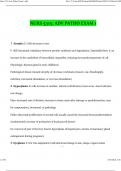Nurs 5315 Adv Patho Exam 1.pdf file:///C:/Users/HP/Desktop/SSSSSSS/Nurs%205315%20Adv%20P
NURS 5315: ADV PATHO EXAM 1
1. Atrophy: E. Cells decrease in size
P. Still functional; imbalance between protein synthesis and degradation. Essentially there is an
increase in the catabolism of intracellular organelles, reducing structuralcomponents of cell
Physiologic: thymus gland in early childhood
Pathological: disuse (muscle atrophy d/ decrease workload, pressure, use, bloodsupply,
nutrition, hormonal stimulation, or nervous stimulation)
2. Hyperplasia: E: cells increase in number, mitosis (cell division) must occur, sizeof cell does
not change
Phys: increased rate of division, increase in tissue mass after damage or partialresection; may
be compensatory, hormonal, or pathologic
Patho: abnormal proliferation of normal cells usually caused by increased hormonalstimulation
(endometrial). increase of production of local growth factors
Ex: removal of part of the liver lead to hyperplasia of hepatocytes. uterine ormammary gland
enlargement during pregnancy
3. Dysplasia: E. Not true adaptation; Cells abnormal change in size, shape, organi-zation
1 of 96 8/30/2024, 3:36
,Nurs 5315 Adv Patho Exam 1.pdf file:///C:/Users/HP/Desktop/SSSSSSS/Nurs%205315%20Adv%20P
(classified as mild, moderate, severe)
P. caused by cell injury/irritation, characterized by disordered cell growth. aka atyp-ical
hyperplasia or pre-cancer, a disorderly proliferation
Physiologic: N/A
Pathologic: squamous dysplasia of cervix from HPV shows up on pap smear, breast cancer
development; pap smears often show dysplastic cells of the cervix that must undergo
laser/surgical tx
4. Metaplasia: E: reversible change, one type of cell changes to another type forsurvival
P: reversible; results from exposure of the cells to chronic stressors, injury, or irritation; Cancer
can arise from this area, stimulus induces a reprogramming of stemcells under the influence of
cytokines and growth factors
Ex: Patho: Columnar cells change to squamous cells in lungs of smoker or normal ciliated
epithelial cells of the bronchial linings are replaced by stratified squamous epithelial cells.; Phys:
Barrett Esophagus- normal squamous cells change to colum-nar epithelial cells in response to
reflux, aka intestinal metaplasia
5. Hypoxia injury: E. inadequate oxygenation of tissues
P.decrease in mitochondrial function, decreased production of ATP increases anaer-obic metabolism.
eventual cell death.
2 of 96 8/30/2024, 3:36
,Nurs 5315 Adv Patho Exam 1.pdf file:///C:/Users/HP/Desktop/SSSSSSS/Nurs%205315%20Adv%20P
C.M. hypoxia, cyanosis, cognitive impairment, lethargy
6. Free radical and ROS: E. normal byproduct of ATP production, will overwhelmthe
mitochondria- exhaust intracellular antioxidants
P. lipid peroxidation, damage proteins, fragment DNA
3 of 96 8/30/2024, 3:36
,Nurs 5315 Adv Patho Exam 1.pdf file:///C:/Users/HP/Desktop/SSSSSSS/Nurs%205315%20Adv%20P
C.M. development in Alzheimer's, heart disease, Parkinson's disease, AmyotrophicLateral
Sclerosis
7. Ethanol: E. mood altering drug, long term effects on liver and nutritional status
P. metabolized by liver, generates free radicals
C.M. CNS depression, nutrient deficiencies-Mag, Vit B6, thiamine, PO4, inflamma-tion and fatty
infiltration of liver, hepatomegaly, leads to liver failure irreversible
8. Oncosis: Na and H2O enter cell and cause swelling. Organ increases in weight,becomes
distended and pale. Associated with high fever, hypocalcemia, certain infections
9. Fatty Infiltration: intracellular accumulation of lipids in the liver
liver fails to metabolize lipids.usually from ETOH or high fat diet.can lead to cirrhosis
10. dystrophic calcification: accumulation of Ca in dead or dying tissues calcium salt
clump and harden- interfere with cellular structure and functionr/t pulmonary TB,
atherosclerosis, injured heart valves, chronic pancreatitis
11. metastatic calcification: accumulation of Ca in normal tissue
result of hypercalcemia r/t hyperparathyroidism, hyperthyroidism, toxic levels of Vit
D. Can also r/t hyperphosphatemia in renal failure
12. urate accumulation: sodium urate crystals are deposited in tissues- group ofdisorders
4 of 96 8/30/2024, 3:36




